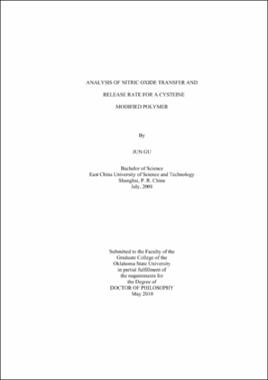| dc.contributor.advisor | Lewis, Randy S. | |
| dc.contributor.author | Gu, Jun | |
| dc.date.accessioned | 2013-11-26T08:31:39Z | |
| dc.date.available | 2013-11-26T08:31:39Z | |
| dc.date.issued | 2010-05 | |
| dc.identifier.uri | https://hdl.handle.net/11244/7154 | |
| dc.description.abstract | Scope and Method of Study: In order to improve the haemocompatibility of biomaterials so that platelet adhesion on the surface can be minimized, a cysteine (CySH) modified polymer was developed previously and preliminary blood contacting test has shown that the modified polymer can inhibit 60% platelet adhesion. The mechanism of this modified polymer is that the immobilized cysteine on the polymer can seize nitric oxide (NO) from S-nitroso-albumin (AlbSNO) in blood through transnitrosation reaction, and then the unstable S-nitroso-cysteine (CySNO) decomposes and release NO, which is a well known platelet inhibitor. However, the reason for incomplete platelet inhibition is unclear since measuring the NO flux from the modified polymer is difficult. Therefore, a detailed kinetic model is required to predict this NO flux. In this study, the kinetics of the associated reactions is investigated and stability of the modified polymer is evaluated and finally, NO flux is estimated by modeling in a tubular flow system. | |
| dc.description.abstract | Findings and Conclusions: CySNO decomposition is sensitive to various environment conditions such as metal ion contamination level, pH and ascorbic acid concentration. Transnitrosation in free solution revealed that CySH is oxidized by metal ion or oxygen in solution during the reaction while ascorbic acid can prevent the oxidation caused metal ion, however, oxidation due to oxygen still exists. On the other hand, previous technique for immobilizing CySH led to an unstable bond which is prone to hydrolyzation in neutral pH. Increased temperature was found to accelerate this hydrolysis significantly. An improved modification method was developed and a stable bond was formed. Out of the aqueous solution, immobilized CySH can also be oxidized when both light and air exists, while at -20C, CySH is very stable on the polymer surface for about 2 months. Immobilized transnitrosation showed that CySH on the polymer performs better than CySH in the free solution as it transferred more than three times of its own amount of BSANO before getting totally oxidized even without ascorbic acid. The calculated kinetic rate constants showed that transnitrosation has mass transfer limiting behavior which is likely due to the cracks on the polymer formed during modification while the CySNO decomposition rate constant is not affected by the cracks. The predicted NO flux by a model is sufficient for the platelet inhibition for previous in vitro blood test, however this flux is highly sensitive to AlbSNO concentration which can be much lower than the value used in the model setup. | |
| dc.format | application/pdf | |
| dc.language | en_US | |
| dc.rights | Copyright is held by the author who has granted the Oklahoma State University Library the non-exclusive right to share this material in its institutional repository. Contact Digital Library Services at lib-dls@okstate.edu or 405-744-9161 for the permission policy on the use, reproduction or distribution of this material. | |
| dc.title | Analysis of nitric oxide transfer and release rate for a cysteine modified polymer | |
| dc.contributor.committeeMember | Johannes, A. J. | |
| dc.contributor.committeeMember | Foutch, Gary Lynn | |
| dc.contributor.committeeMember | Madihally, Sundararajan V. | |
| dc.contributor.committeeMember | Ford, Warren T. | |
| osu.filename | Gu_okstate_0664D_10507 | |
| osu.accesstype | Open Access | |
| dc.type.genre | Dissertation | |
| dc.type.material | Text | |
| dc.subject.keywords | cysteine immobilization | |
| dc.subject.keywords | modeling | |
| dc.subject.keywords | nitric oxide | |
| dc.subject.keywords | polyethylene terephthalate modification | |
| dc.subject.keywords | s-nitrosothiol | |
| dc.subject.keywords | transni | |
| thesis.degree.discipline | Chemical Engineering | |
| thesis.degree.grantor | Oklahoma State University | |
